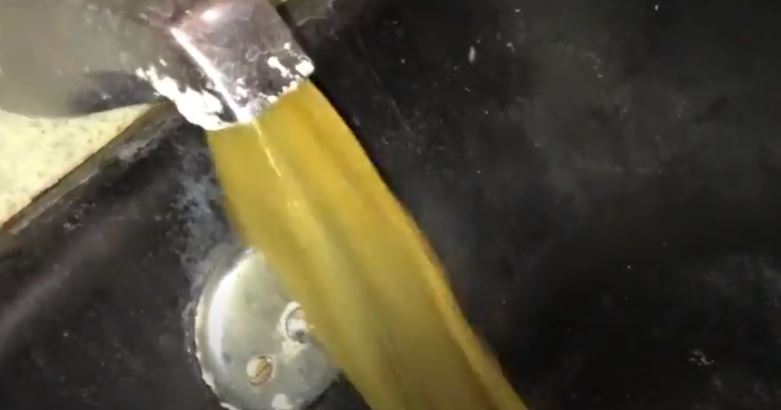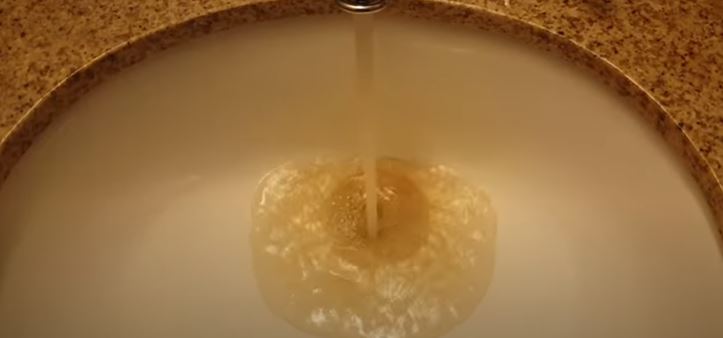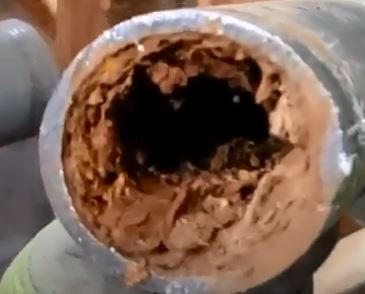
Causes of Yellow Water in a Tap or Bathtub and Solutions
- Rusty Pipes: Corroded or rusty pipes can lead to yellow or brownish water. Over time, iron in the pipes can leach into the water supply.Solution: If the issue is localized to one tap or fixture, consider replacing or cleaning the affected pipes or fixtures. For widespread rust in your plumbing system, consult a plumber for pipe replacement.
- Sediment Buildup: Sediment, minerals, or debris can accumulate in the water supply or pipes, causing discoloration.Solution: Install a sediment filter on your main water line to reduce the presence of particles. Periodically flush your water heater to remove sediment buildup. Consult a plumber for professional flushing if needed.
- Municipal Water Issues: The yellow water may originate from the municipal supply due to issues like maintenance work, nearby construction, or changes in water source.Solution: Contact your local water utility for information about water quality and possible issues in the municipal supply. They can provide guidance and updates.
- Well Water Contamination: In homes with well water, contamination from minerals, iron, or organic matter can cause discoloration.Solution: Test your well water for contaminants and work with a well water specialist to implement filtration or treatment systems as needed.
- Water Heater Problems: Sediment buildup in the water heater can lead to discolored water when the heater is used.Solution: Regularly flush the water heater to remove sediment. Consider professional maintenance if the problem persists.
- Galvanized Pipes: Homes with galvanized steel pipes may experience yellow water due to corrosion.Solution: Replace galvanized pipes with newer, corrosion-resistant materials like copper or PEX.
Note: Yellow water can sometimes be associated with health concerns, particularly if it’s due to heavy metals or contaminants. If you suspect water quality issues, consider getting your water tested by a certified lab.
- Temperature Changes: Occasionally, cold water sitting in pipes can cause discolored water when it’s first turned on.Solution: Run the tap for a few minutes to flush out any discolored water before using it for cooking or drinking.
- Chemical Reactions: Chemical reactions between water and certain plumbing materials or fixtures can result in discoloration.Solution: Consult a plumber to identify the source of the chemical reaction and replace any problematic components.
- Local Construction Activity: Nearby construction or excavation work can disrupt water pipes, leading to sediment and discoloration.Solution: Wait for the construction work to conclude. If the issue persists, contact your local water utility or a plumber for assistance.
How to Fix Yellow Water from Tap/Bathtub

The first thing you need to do when you start seeing yellow water in your house is to investigate if it is affecting the whole house or just part of the plumbing. The second thing you will need to determine is if the water is affecting both the cold and hot water.
Here is how you can fix yellow water from a faucet:
1. Yellow Water that Clears out After a Few Seconds
If the yellow water appears when you turn on the tap (especially in the morning) then clears after a few seconds, the problem is most likely old corroded pipes. The rust flakes off as the water is flowing through the pipe but as soon as the rust is flushed out the water clears.
Most old homes have galvanized steel pipes. Galvanized steel is basically steel dipped in molten zinc. Unlike steel, zinc does not corrode.
After years of usage, the zinc coat peels off (inside the pipe not outside) and the steel pipes starts to corrode. Corrosion is severe on the hot water lines than on the cold water lines.

Apart from yellow water, corroded pipes are more likely to clog and reduce the water pressure in your house. Other than that, the more the pipes corrode the more they become weak thereby increasing their likelihood of bursting causing water damage.
You can try to flush your pipes and see if that fixes the problem. My advice however would be to replace the old pipes with new PEX or copper pipes. More on galvanized steel pipes in this post.
2. Yellow Water from the City
Just like the pipes in your house, your local municipal water pipes will have sediments buildup and the city will therefore flush them from time to time to make sure that you get clean water and at the right pressure.
As the city flushes the water lines, the sediment will be stirred/agitated and forced to your house (and the neighbors as well). The result of this is that all the iron and manganese will dissolve in the water at a high concentration and hence the yellow water.
If you notice yellow water flowing from all over your house, this could be the reason. Check with your neighbors to see if they are experiencing the problem as well.
Alternatively, you can pick up the phone and call the water utility company and ask if they have recently flushed their lines and when to expect the water to clear up.
With yellow water from the city, there is nothing more you can do other than wait. You may need to clean your faucet aerators and shower heads later in case the sediment has clogged them as well, which reduces the water pressure.
3. Yellow Hot Water
If the cold water in your house is clear but the hot water is yellow, the problem is most likely your water heater. Sediment build up at the bottom of the water heater (especially iron and manganese) will cause the water to turn yellow.
When water flows into the water heater, some of the dissolved minerals will settle at the bottom of the tank causing a sediment buildup.
It is important to remember that the more the water is heated the more its ability to dissolve minerals increases. This is why sugar dissolves easily in hot tea/coffee.
As the water in the water heater is heated, it dissolves the iron and manganese resulting in yellow hot water when you turn the bathtub faucet.
Another thing to remember is that your water heater has a sacrificial anode rod which reacts with elements in water. The anode rod is made of a lesser noble metal that the inner lining of the water heater hence it is sacrificed instead of the water heater.
If the anode rod is depleted and not replaced, the inner walls of the water heater will start to corrode, which could be the source of your yellow water. Check out how to replace a water heater anode rod here.
Other that replacing the anode rod, there are 2 things you can do to fix the problem. You can either flush out the sediment or replace the water heater.
If your water heater is more than 10 years old, you may need to replace it. I have written a detailed guide on the signs that indicate you need to replace your water heater. Read it here.
Most of the time, flushing your water heater will be enough to fix the problem. Here is how to do it:
- Turn off power to your water heater if you have an electric water heater or turn off gas to a gas water heater.
- Look for a shut off valve on the water heater’s cold water line. Turn it off as well.
- Connect a garden hose on the water heater drain valve and turn on the drain valve with flathead screwdriver.
- As the water is draining out, turn on the nearest hot water faucet to fasten the draining process. Leave the faucet open.
- When all of the water has drained out, turn on the cold water supply. The cold water will agitate the sediment left at the bottom of the tank. Turn the valve off and on again a couple of times until only clear water is flowing out.
- Turn off the drain valve and remove the garden hose.
- Start filling the tank with water. As the tank fills, air will escape through the faucet you left open. This prevents air from being trapped in the water heater. When the faucet stops spitting out air turn it off.
- Turn on the power to the water heater or light the pilot.
- Check if the yellow water has cleared out.
It is recommended that you flush your water heater at least once a year.
4. Yellow from a Well
If you use water from a private well and are experiencing a yellow discoloration of water, it could be caused by iron bacteria, decaying organic matter but most of the time is due to dissolved iron or manganese.
This happens when the rock above the water contains high levels of iron or the water source has been in contact with iron-bearing minerals. As rain water percolates through the soil, it goes through the iron-bearing rock thereby dissolving it and taking it to the source of your ground water.
Apart from the yellow color, the water may also have a metallic taste or a bad smell as well.
It is worth noting that there are 2 types of iron that could be present in your well water. These are ferric iron and ferrous iron.
Ferric iron is the one that you can see (the one that turns water yellow, red or brown) while ferrous iron cannot be seen once dissolved in water. Ferrous iron has not yet been oxidized and cannot be captured by a filter while ferric iron has been oxidized and can be captured by a filter.
Ferric iron, which is what we are dealing with in this case, can be removed by installing a water filter. The type of water filter will however depend on the amount of iron present.
If your house contains small amounts of ferric iron you will need to install a cartridge filter.
Houses with high amounts of ferric iron will need to have backwashing sediment filter installed. You can then install a cartilage filter depending on the severity of the problem.
You will most likely need to hire a professional plumber to advice and install the best water filter based on their assessment.
And basically that is how to fix yellow water from your tap. I hope this guide was of help to you.






